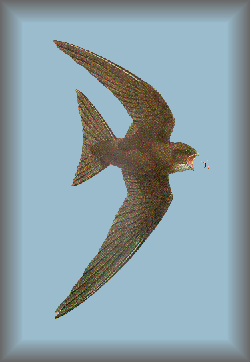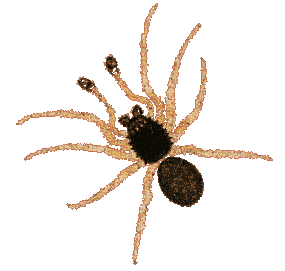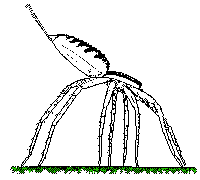Spider of the Month - August
 Yes
- I know it's a bird, when you were expecting a nice picture of a spider!
Yes
- I know it's a bird, when you were expecting a nice picture of a spider!
To be precise, it's a swift, Apus apus - but read on ...
It's high summer in Scotland.
After a fine, hot sunny day the evening air is filled with the screeching
sounds of many swifts as they swoop overhead around the rooftops and along
the streets.
Their mouths are gaping wide open as they feed on the aerial plankton
- flying insects and aeronautic spiders.
That's one of the swifts shown in the picture and if you look closely,
you can see that it's about to catch a spider!
The unfortunate victim is a specimen of this month's species: Erigone
dentipalpis.
In fact, it's a male, but you need to look at the bigger picture to
be able to tell.
At the front of the spider you can now see his palps, with their enlarged
tarsi (the end segment of the limb) which are used to transfer sperm into
the female when they are mating.
He's quite impressive really isn't he,
even if he's only about 1 - 2 millimetres long!
Erigone is a member of the family Linyphiidae. It's one of those
linyphiine genera which lives in amongst moss, leaf litter, grass stems,
etc. close to the soil surface. In Britain there are several species of
Erigone,
tending to occupy slightly different habitats.
As members of the cryptozoa, these species are generally unobtrusive
and not noticed by the unsuspecting person - until large numbers of them
start flying about on the breeze in summer and other times of year.
So, what about this flying activity?
Well, there are many species in several families of spiders which make
use of air currents for dispersal.

The spider lets out threads of silk, which are caught up on the breeze.
Raising itself up "on tiptoe", as shown in this illustration,
the spider lets out enough silk until the surface area of the threads
is sufficient for the movement of the air to lift the spider
- and away it goes, carried on the wind to land perhaps somewhere far
away where it can settle if habitat conditions are suitable.
By the way, as you can possibly tell, this little fellow about
to take off is not an Erigone - nor even a member of the Linyphiidae!
Erigone dentipalpis is one of these aeronautic species, as is
its close relative Erigone atra. I have often caught large numbers
of both species in pitfall traps in open habitats such as short, wet grassland.
The mortality rate must be horrendous - if they are not eaten by birds
such as the swift on the wing, then the spiders must land in a suitable
habitat to survive. Under favourable conditions, large numbers of aeronautic
spiders can occur. Their webs can drape over the vegetation as gossamer
and some people regard it as lucky if one of these flying spiders lands
on them - a common English name for them is "money spiders".
I suspect that members of the family Theridiidae, to which last
month's spider belongs are also aeronauts. If you have information
on this, please let me know.
The picture of E. dentipalpis is again from the book by Dr. Mike
Roberts : The Spiders of Great Britain and Ireland, published by
Harley Books in 1985, and the picture of the "aeronaut at take-off" is
from The World of Spiders by W.S. Bristowe, originally published
in the New Naturalist series by Collins in 1958.

 Yes
- I know it's a bird, when you were expecting a nice picture of a spider!
Yes
- I know it's a bird, when you were expecting a nice picture of a spider!

 Ariadne Home Page
Ariadne Home Page